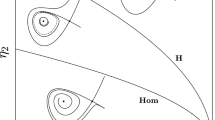Abstract
A dynamical system is said to be reversible if there is an involution of phase space that reverses the direction of the flow. Examples are Hamiltonian systems with quadratic potential energy. In such systems, homoclinic orbits that are invariant under the reversible transformation are typically not destroyed as a parameter is varied. A strategy is proposed for the direct numerical approximation to paths of such homoclinic orbits, exploiting the special properties of reversible systems. This strategy incorporates continuation using a simplification of known methods and a shooting approach, based on Newton's method, to compute starting solutions for continuation. For Hamiltonian systems, the shooting uses symplectic numerical integration. Strategies are discussed for obtaining initial guesses for the unknown parameters in Newton's method. An example system, for which there is an infinity of symmetric homoclinic orbits, is used to test the numerical techniques. It is illustrated how the orbits can be systematically located and followed. Excellent agreement is found between theory and numerics.
Similar content being viewed by others
References
C.J. Amick and J.F. Toland, Homoclinic orbits in the dynamic phase-space analogy of an elastic strut, Eur. J. Appl. Math. 3(1992)97–114.
U. Ascher and R.D. Russell, Reformulation of boundary value problems into “standard” form, SIAM Rev. 23(1981)238–254.
W.-J. Beyn, The numerical computation of connecting orbits in dynamical systems, IMA J. Num. Anal. 9(1990)379–405.
A.R. Champneys and A. Spence, The numerical computation of homoclinic orbits in reversible systems (1993), in preparation.
A.R. Champneys and J.F. Toland, Bifurcation of a plethora of large amplitude homoclinic orbits for autonomous Hamiltonian systems, Nonlinearity (1993), submitted.
B. Buffoni, A.R. Champneys and J.F. Toland, Bifurcation and coalescence of a plethora of homoclinic orbits for a Hamiltonian system (1993), in preparation.
R.L. Devaney, Reversible diffeomorphisms and flows, Trans. Amer. Math. Soc. 218(1976)89–113.
R.L. Devaney, Blue sky catastrophes in reversible and Hamiltonian systems, Indiana Univ. Math. J. 26(1977)247–263.
E. Doedel, AUTO, a program for the automatic bifurcation analysis of autonomous systems, Cong. Numer. 30(1981)265–284.
E. Doedel, Numerical analysis and control of bifurcation problems, Report No. 89/17, Supercomputer Institute, University of Minnesota (1989).
E. Doedel and M.J. Friedman, Numerical computation of heteroclinic orbits, J. Comput. Appl. Math. 26(1989)159–170.
E. Doedel and J.P. Kernévez, AUTO: Software for continuation problems in ordinary differential equations with applications, Applied Mathematics Technical Report, California Institute of Technology (1986).
M.J. Friedman and E. Doedel, Numerical computation of invariant manifolds connecting fixed points, SIAM J. Numer. Anal. 28(1991)789–808.
P. Glendinning, Global bifurcations in flows, in:New Directions Dynamical Systems, ed. T. Bedford and J. Swift (Cambridge University Press, 1988).
J. Guckenheimer and P. Holmes,Nonlinear Oscillations, Dynamical Systems and Bifurcations of Vector Fields (Springer, 1983).
G.W. Hunt, H.M. Bolt and J.M.T. Thompson, Structural localisation phenomena and the dynamical phase-space analogy, Proc. Roy. Soc. London A425(1989)245–267.
G.W. Hunt and M.K. Wadee, Comparative Lagrangian formulation for localized buckling, Proc. Roy. Soc. London A434(1991)485–502.
G. Iooss and K. Kirchgässner, Bifurcation d'ondes solitaires en présence d'une faible tension superficielle, C.R. Acad. Sci. Paris, Ser. 1, 311(1991)265–268.
L.W. Johnson and R.D. Riess,Numerical Analysis, 2nd ed. (Addison-Wesley, 1982).
P. Kent and J. Elgin, Travelling-waves of the Kuramoto-Sivashinsky equation — period multiplying bifurcations, Nonlinearity 5(1992)899–919.
R.I. MacLachlan and P. Atela, The accuracy of symplectic integrators, Nonlinearity 5(1992)541–562.
R.D. Ruth, A canonical integration technique, IEEE Trans. Nucl. Sci. NS-30(1983)2669–2671.
J.M. Sanz-Serna, Symplectic integrators for Hamiltonian problems: an overview, Acta Numerica (1992) 243–286.
L.P. Šil'nikov, A case of the existence of a countable number of periodic motions, Sov. Math. Dokl. 6(1965)163–166.
C. Sparrow,Lorenz Equations: Bifurcations, Chaos, and Strange Attractors (Springer, 1982).
S. Wiggins,Global Bifurcations and Chaos; Analytical Methods (Springer, 1988).
Author information
Authors and Affiliations
Additional information
This paper is presented as an outcome of the LMS Durham Symposium convened by Professor C.T.H. Baker on 4–14 July 1992 with support from the SERC under grant reference number GR/H03964.
Rights and permissions
About this article
Cite this article
Champneys, A.R., Spence, A. Hunting for homoclinic orbits in reversible systems: A shooting technique. Adv Comput Math 1, 81–108 (1993). https://doi.org/10.1007/BF02070822
Received:
Issue Date:
DOI: https://doi.org/10.1007/BF02070822
Keywords
- Homoclinic orbit
- reversible system
- Hamiltonian system
- continuation
- shooting
- Newton's method
- infinite number of solutions



